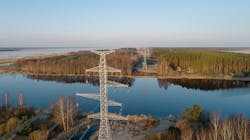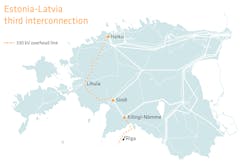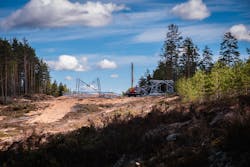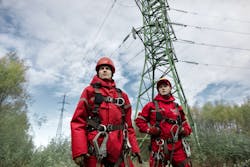Baltic States Add Third Interconnection
However, significant changes have taken place with the energy systems since 2004, when the Baltic States became members of the European Union. The Ignalina nuclear power plant in Lithuania was closed, which was the main source of electricity for the region. Cross-border interconnections were developed with Finland, Sweden and Poland. The electricity market in the Baltics was fully opened and, although the Baltic States are still operating in a synchronous mode with the energy systems of Russia and Belarus, imports of electricity from these two countries have decreased as the Baltic States are importing electrical energy primarily from the EU now.
In addition, it should be noted the plan is to desynchronize the Baltic power systems completely from Russia and Belarus by the end of 2025. They will start synchronous operation with the continental European networks through the alternating-current interconnections between Lithuania and Poland, while providing trade transactions through the direct-current interconnections with Finland, Sweden and Poland.
As the electricity supply routes and conditions have changed, the network’s technical constraints must be addressed. Four 330-kV interconnections exist between Latvia and Lithuania; however, two of the connections were built with Estonia back in the USSR days. The two transmission lines connect Valmiera, Latvia, to Tartu and Tsirguliina, Estonia, respectively. Although both connections are located within less than 100 miles (161 km) from end to end, the current transmission lines have insufficient load-transfer capacity. New technical constraints and operational requirements for transmission lines in Latvia and Estonia created a need for a third transmission line interconnection.
A Third Line
Preliminary work on the new interconnection project began in 2009 by conducting a right-of-way (RoW) study to identify the most suitable and feasible routes. The study was followed by a project initiative submission to the Environment State Bureau (ESB) of Latvia in 2012. Then, in 2014, an environmental impact assessment was started followed by public consultations with the impacted municipalities. Based on a joint application from the two transmission system operators (TSOs) — AS Augstsprieguma tīkls (AST) in Latvia and AS Elering in Estonia — the project received 65% of construction costs (co-financing) from the Connecting Europe Facility (CEF) in October 2014.
In 2016, a procurement procedure was announced for the design and construction works as well as a decision by the Cabinet of Ministers of Latvia to allocate the status of the project as an object of national interest, thereby giving it high importance on a national and EU level. Construction of the new transmission line began in early 2018.
Interconnection Design
The development plan for the project included the following options:
- A 330-kV high-voltage overhead transmission line constructed from the Riga CHP-2 substation to the Estonian border, at 176 km (109 miles) in length within Latvia, for connection to a new overhead transmission line constructed on the Estonian side of the border.
- A section of the new transmission line, some 28 km (17 miles) in length, constructed from the Estonian border to the existing transmission line between the Latvian municipalities of Rujiena and Aloja, which would then continue along the corridor of an existing 110-kV line crossing the Aloja, Limbazi and Skulte municipalities up to Saulkrasti. From there, the transmission line would stretch into the corridor of the future Rail Baltica railway project.
- Expand the Riga CHP-2 substation in Latvia and build a section of the transmission line in Estonia to connect it to an existing 330-kV Kilingi-Nōmme substation and construct a new 330-kV overhead transmission line from Harku to Sindi.
As a result of the overall assessment of the technical and economic parameters of the possible interconnection routes, AST jointly with AS Elering concluded the best option for the third Estonia-Latvia overhead line interconnection would be the route between the Kilingi-Nōmme substation in Estonia and the Riga CHP-2 substation in Latvia. This selected route had lower construction costs and, more importantly, the most substantial increase in cross-border load-transfer capacity (that is, 500/600 MW in both directions).
Rail And Marshlands
The new 330-kV overhead line interconnection is supported by classic hot-dip galvanized-steel lattice towers. The pylons were manufactured in Turkey and transported disassembled to Latvia, where they were assembled and then lifted onto prebuilt foundations. Because of the swampy terrain on the route closer to Estonia, construction of the pylons presented a challenge for the constructors because a footbridge had to be built so equipment could access the locations where the pylons needed to go. In addition, groundwater drainage was required in areas close to the foundations.
In both the existing and new overhead line corridors, the width of the RoW was constant at 54 m (177 ft) of trimmed area. The width of the line protective zone is 12 m (39 ft) from the outer conductor in the cities and 30 m (98 ft) in unpopulated areas. In forests, the protective zone is defined as 40 m (131 ft) from the line axis.
A section of the 330-kV overhead line interconnector has been constructed with a protective zone that overlaps the protective zone of the new Rail Baltica railway project. When the railroad project is finalized, the third overhead line interconnector will be just 50 m (164.1 ft) from the railway line. This proved to be challenging for all parties involved, and several studies had to be undertaken on the specifics of both project infrastructures before an all-party agreement was reached.
Timetable And Expenditure
The design and construction works of the power transmission line in Latvia was undertaken by the general partnership EE-LV Interconnection — consisting of Latvian SIA Elko, Polish JSC SELPOL and Estonian JSC Leonhard Weiss Energy — while the work at the Riga CHP-2 substation was performed by Empower AS Latvia.
With the first pylon constructed in May 2019, the 330-kV overhead transmission line from the RIGA CHP-2 substation to the Estonian border took almost two years to complete. The construction of the interconnection was finalized in December 2020 and commissioned in March 2021.
In total, the cost of this third interconnection project from the 330-kV Riga CHP-2 substation in Latvia to the 330-kV Kilingi-Nōmme substation in Estonia — together with the Estonian 330-kV transmission line between Harku and Sindi was €170 million (US$ 192 million), of which €79 million ($US89 million) was attributable to the works undertaken in Latvia. Overall, this project was co-financed by the EU, with €112 million (US$ 127 million) from the CEF.
The Bottleneck
The third Estonia-Latvia 330-kV interconnection is an important step toward improving the security and reliability of power supply as well as the energy independence of Latvia. It also is a significant step toward developing a more efficient electricity market, as it enables both countries to increase cross-border electricity trading.
The existing cross-border interconnections between Estonia and Latvia were the most congested of the Baltic electricity transmission network. Since the opening of the electricity market, its capacity was insufficient to meet the needs of cross-border trading. In the last three years before construction of the new interconnection, congestion on the Estonian-Latvian cross-border amounted to some 30%.
To eliminate the technical restrictions in the Estonian transmission network completely, the TSO plans to redo the existing 330-kV transmission lines in the coming years. These reconstructions will be done gradually so as not to reduce the cross-border capacity.
Increased Security
The interconnection project has significantly improved the security of energy supply in the cross-border between Estonia and Latvia. The new interconnection was built in the separate corridor and connects two substations in the Latvian and Estonian transmission networks. The two existing 330-kV interconnection lines are geographically located in the same corridor and connected to the same 330-kV substation in Valmiera, Latvia.
The new construction also has had a positive impact on the voltage levels and dynamic stability of the power system, especially in emergency network modes. Emergency situations in the past, such as outages in large power plants in Latvia and Lithuania, endangered the power-supply security in the whole Baltic region. TSOs previously have been forced to significantly reduce the cross-border capacity available on the electricity market.
Moreover, in 2025, when the Baltic electricity systems start operating synchronously with continental Europe, the third interconnection project will serve as a precondition for maintaining the secure and stable operation of the Baltic electricity systems.
Corridor Development
The new interconnection provides a reliable transit corridor between the Baltic and Nordic electricity systems from the north through the Estonia-Finland Estlink-1 and Estlink-2 interconnections and to the south through NordBalt, the existing LitPol link and the planned Harmony link with the Lithuania-Poland cross-border.
After commissioning of all these planned interconnection projects, the reinforced electricity system of the Baltic States and its connections with the transmission systems of the Nordic countries and continental Europe will serve as a reliable and stable alternative route for importing and exporting electric power from the Nordic countries to continental Europe.
Increased Capacity
The 330-kV power transmission line developed by Latvian TSO AS Augstsprieguma tīkls (AST) and Estonian TSO AS Elering was the first cross-border transmission line constructed since the Baltic States regained their independence. The line became operational in December 2020, although the formal commission date was in March 2021 followed by the official opening in August 2021.
The new interconnection has increased the transmission capacity of the current Estonia-Latvia cross-border by at least 600 MW. Before this new line, capacity was insufficient for the required volume of electricity traded between Latvia and Estonia, which resulted in frequent congestions and electricity price differences at certain hours. The project also has been important for security of the energy supply and stable operation of the electricity transmission network in both Latvia and Estonia as well as in the Baltics as a whole.
Antons Kutjuns ([email protected]) received his Ph.D. degree from the Riga Technical University in 2006, where he focused on power system reliability. He is now head of the research and development division at JSC Augstsprieguma tīkls (AST), the electricity transmission system operator in Latvia, where he has been working for 15 years. Parallel to his responsibilities at AST. Kutjuns conducts in-depth research on power system development, reliability, liberalized electricity market and renewable energy. To date, he has authored 36 scientific papers.
Lāsma Līvzeniece ([email protected]) recently obtained her second master’s degree from the Riga Technical University on environmental studies and renewable energy. Currently, she is the acting head of communications at JSC Augstsprieguma tīkls (AST), the electricity transmission system operator in Latvia. Līvzeniece has been working in the field of energy for more than 10 years, holding various positions in international wind energy organisations based in Belgium and Latvia.







